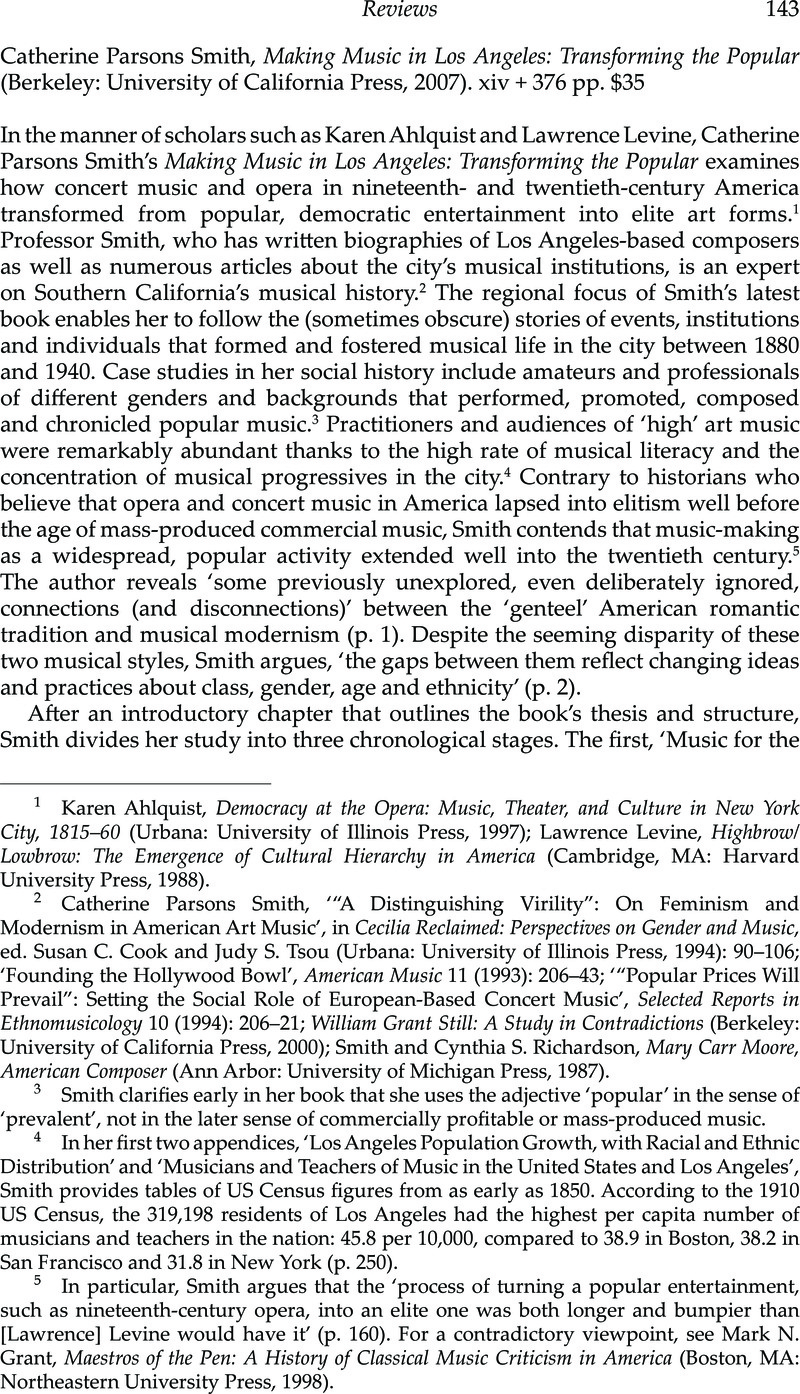No CrossRef data available.
Published online by Cambridge University Press: 13 April 2011

1 Ahlquist, Karen, Democracy at the Opera: Music, Theater, and Culture in New York City, 1815–60 (Urbana: University of Illinois Press, 1997)Google Scholar; Levine, Lawrence, Highbrow/Lowbrow: The Emergence of Cultural Hierarchy in America (Cambridge, MA: Harvard University Press, 1988)Google Scholar.
2 Smith, Catherine Parsons, ‘“A Distinguishing Virility’: On Feminism and Modernism in American Art Music’, in Cecilia Reclaimed: Perspectives on Gender and Music, ed. Cook, Susan C. and Tsou, Judy S. (Urbana: University of Illinois Press, 1994): 90–106Google Scholar; ‘Founding the Hollywood Bowl’, American Music 11 (1993): 206–43Google Scholar; ‘“Popular Prices Will Prevail”: Setting the Social Role of European-Based Concert Music’, Selected Reports in Ethnomusicology 10 (1994): 206–21Google Scholar; Still, William Grant: A Study in Contradictions (Berkeley: University of California Press, 2000)Google Scholar; Smith, and Richardson, Cynthia S., Mary Carr Moore, American Composer (Ann Arbor: University of Michigan Press, 1987)Google Scholar.
3 Smith clarifies early in her book that she uses the adjective ‘popular’ in the sense of ‘prevalent’, not in the later sense of commercially profitable or mass-produced music.
4 In her first two appendices, ‘Los Angeles Population Growth, with Racial and Ethnic Distribution’ and ‘Musicians and Teachers of Music in the United States and Los Angeles’, Smith provides tables of US Census figures from as early as 1850. According to the 1910 US Census, the 319,198 residents of Los Angeles had the highest per capita number of musicians and teachers in the nation: 45.8 per 10,000, compared to 38.9 in Boston, 38.2 in San Francisco and 31.8 in New York (p. 250).
5 In particular, Smith argues that the ‘process of turning a popular entertainment, such as nineteenth-century opera, into an elite one was both longer and bumpier than [Lawrence] Levine would have it’ (p. 160). For a contradictory viewpoint, see Grant, Mark N., Maestros of the Pen: A History of Classical Music Criticism in America (Boston, MA: Northeastern University Press, 1998)Google Scholar.
6 Hobsbawm, Eric, ‘Introduction: Inventing Traditions: Europe, 1870–1914’, in The Invention of Tradition, ed. Hobsbawm, Eric and Ranger, Terence (Cambridge: Cambridge University Press, 1983): 263–307.Google Scholar
7 Other than noting the ways local musicians were affected by the advent of the film industry, particularly by the rise and decline of silent film theatre orchestras, Smith devotes little attention to the film industry in Los Angeles. She offers a brief discussion of opera and film on pp. 161–2.
8 Preston, Katherine, Opera on the Road: Traveling Opera Troupes in the United States, 1825–60 (Urbana: University of Illinois Press, 1993).Google Scholar
9 A 1927 promotional pamphlet listed more than 20 music schools and 178 women's music clubs in Los Angeles (pp. 188–90). For a broader study of female music-making, see Locke, Ralph P. and type="authors">Barr, Cyrilla, Cultivating Music in America: Women Patrons and Activists since 1860 (Berkeley and Los Angeles: University of California Press, 1997).Google Scholar Smith's chapter on the New Negro Movement contains only a few pages on composer William Grant Still; for more information, readers may consult her book William Grant Still: A Study in Contradictions.
10 The two earlier histories of music in Los Angeles that Smith cites are Splitter, Henry W., ‘Music in Los Angeles’, Historical Society of Southern California Quarterly 38/4 (Dec. 1956): 307–44; andGoogle ScholarSwan, Howard, Music in the Southwest (San Marino, CA: Huntington Library, 1952).Google Scholar The latter relies heavily upon Behymer's unreliable accounts of his own achievements (p. 3).